Movie tastes have changed significantly from decade to decade. Join us as we examine how audiences have embraced movie genres over the course of each decade from the 1940’s to today.
Since its inception, the motion picture industry has both directed and catered to audience expectations. Movies with unique perspectives which struck a chord with audiences tend to do well in theaters. This success inspires not only sequels of that original film, but competing films which do something similar. As much as we herald those filmmakers who were the pioneers in the industry, it is unfortunately those projects which follow in their footsteps which are the ones that generate revenue.
However, an idea for a movie is only good until a better one comes along. As time goes on, and pop culture changes to reflect the desires and interests of the general population, so does demand for certain types of films. What allowed studios to make the most profits in the 1940’s would certainly not work very well today, and vice versa would be true also. The film industry, especially the upper echelon of the most popular films, is constantly changing. There are very few examples of types or franchises of films which have been able to persevere without significant changes to meet the ever-shifting demands of audiences.
To explore just how audience tastes have changed over time, I decided to look at the genres of the top ten highest grossing films of every year from 1943 to 2021. This gives us 80 years of data to see how the genres have evolved over time. I narrowed down the possible genres to 14. Most films fall into more than one genre, and so I decided to focus on the genre which comes to mind first for a given film (for example, Independence Day is science fiction, action, and disaster, but I count it only as science fiction). The films I chose to examine are the highest grossing DOMESTIC (US and Canada) films for each year, and some of the early years did not have official numbers for enough films to make it an even 10.
I decided to make Rom-Coms their own genre because they didn’t quite fit into either a drama category or a comedy category, and they are popular enough to be on their own. Likewise, I created a comic book/superhero genre even though they are technically action movies. They have really become their own genre. Finally, fantasy movies are included with adventure/epic movies. War movies are those movies which have a historic setting, but are more action-oriented than a drama. I didn’t include them as action movies because their primary goal is to recreate the past, not relish in violence.
Here’s an overview of these films and their genres over time:
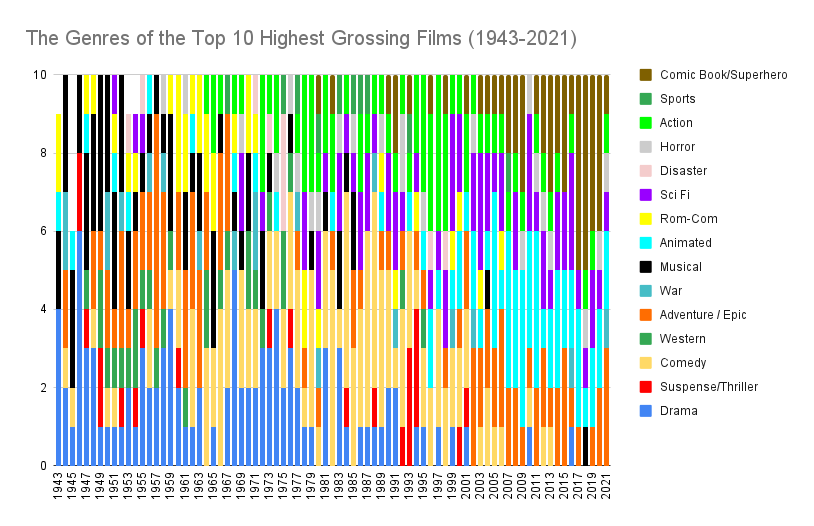
Next, we’ll take a look decade-to-decade. The last chart only shows 2010-2019, even though I collected data for 2020 and 2021.
1940’s:
Most Popular Genre = Dramas
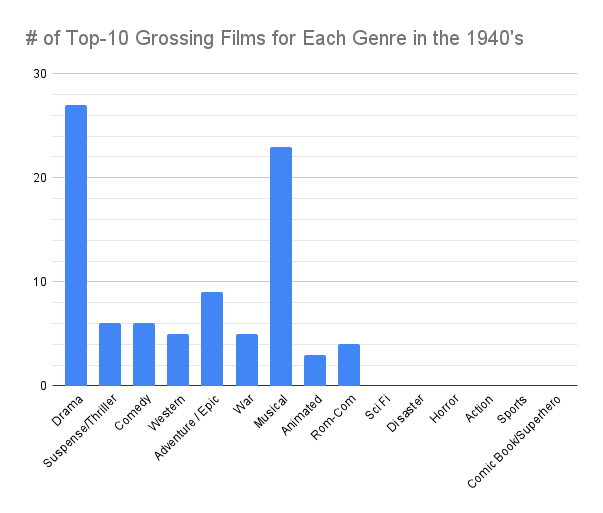
1950’s:
Most Popular Genre = Adventure / Epic Movies
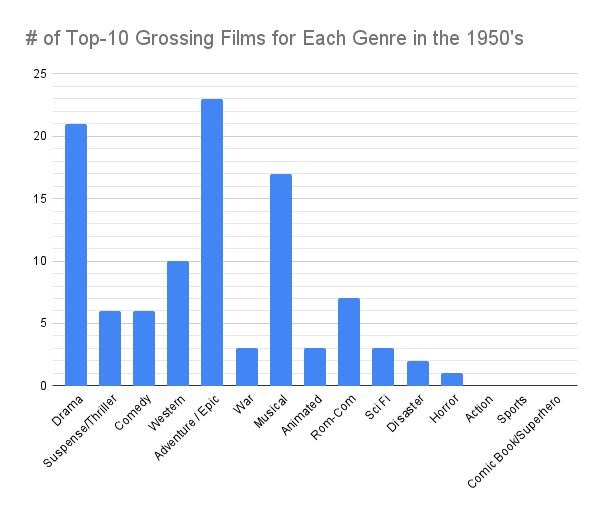
1960’s:
Most Popular Genre = Comedies
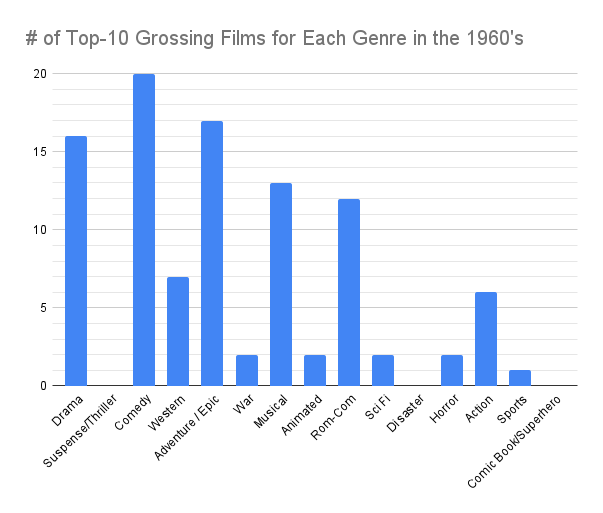
1970’s:
Most Popular Genre = Dramas
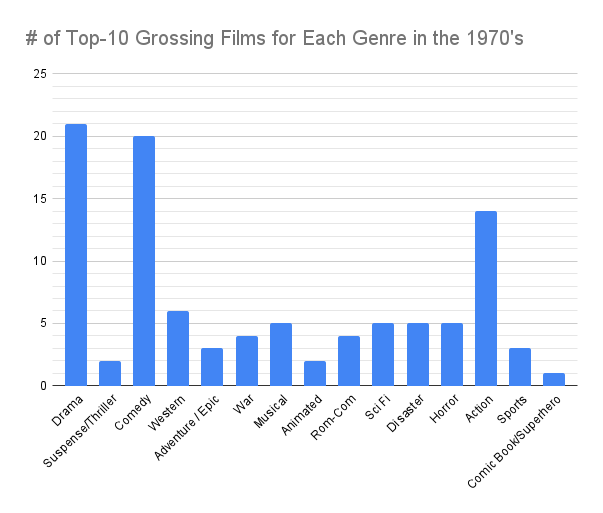
1980’s:
Most Popular Genre = Comedies
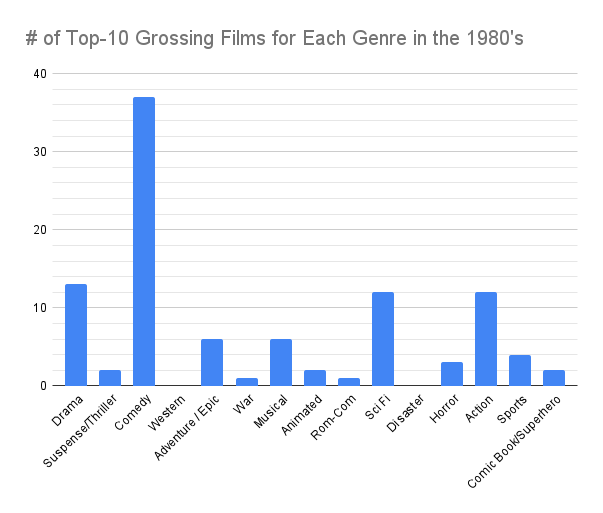
1990’s:
Most Popular Genre = Comedies / Action Movies close second
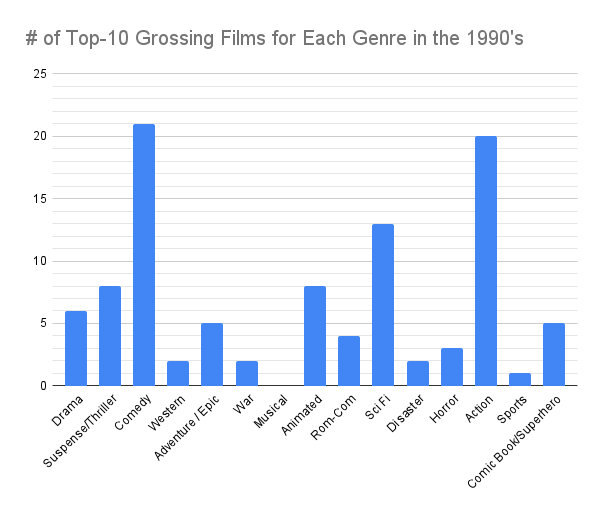
2000’s:
Most Popular Genre = Animated Movies
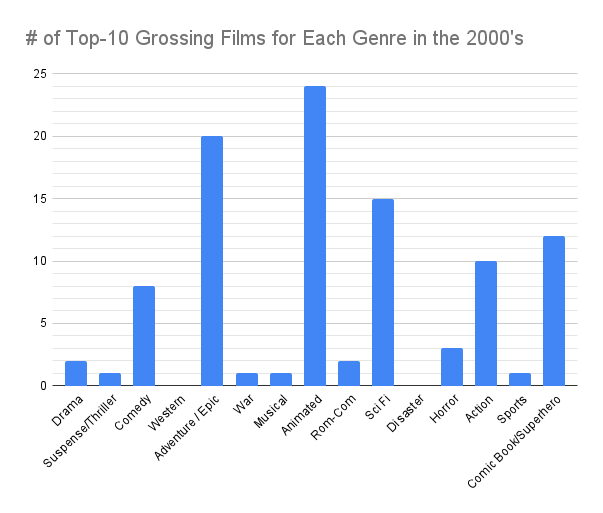
2010’s:
Most Popular Genre = Comic Book / Superhero Movies
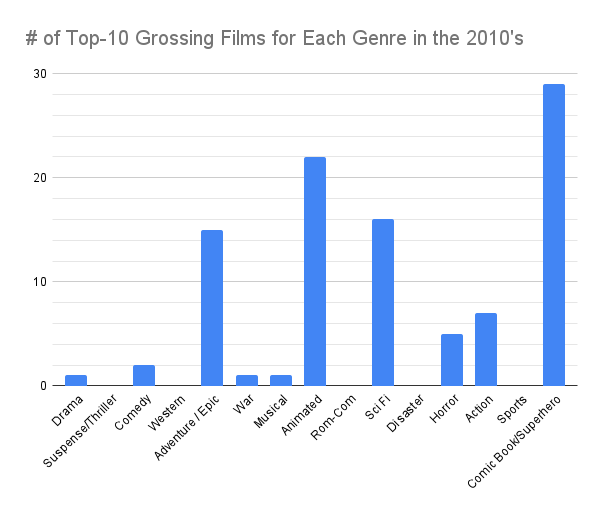
Finally, let’s now examine how each genre has evolved over time, and note some important observations…
Drama
Drama films were at their height in the 40’s and 50’s, with a resurgence in the 70’s and early 90’s. When you think about the development of the industry, this makes sense. Dramas in the 40’s and 50’s were noirs and romances. The types of films which would not be as popular or prevalent later on. Similarly, the drama was most popular during and shortly after WWII. This coincides with the types of films which were made at that time – war dramas and romances. In the 70’s, with the grittier New Hollywood movement, dramas were reborn again. Movies like The Deer Hunter or The Graduate not only shook up the industry, but became popular with audiences too. In the 90’s there was a slight resurgence as the era of the “indie film” took over, and some of those proved to be very popular. Today, dramas very rarely compete with blockbusters in theaters, and so they have mostly fallen off the box office charts.
Suspense/Thriller
Popular in the 40’s and 50s, with a resurgence in the 90’s. These films follow in the footsteps of the drama, being popular during and right after WWII. Think of noir mystery films and courtroom dramas. In the 90’s studios were looking to make edgier mid-budget films to compete with action blockbusters, so we saw the release of films like Basic Instinct, and The Firm.
Comedy
Comedy films have been box office staples up until very recently. They were especially popular in the 50’s through the 80’s. In the 1950’s, they were often family-oriented, which makes sense to cash in on the post-war boom. That trend continued into the 60’s. You would think the popularity of comedies would have dropped off in the 70’s with the introduction of more serious and realistic films, but that was not the case. Hollywood continued to churn out family-friendly films, and people kept taking their kids to the movies to see them. This trend continued in the 80’s despite the advent of the blockbuster. Even in the 90’s there were many very popular comedy films, mostly from Jim Carey and Adam Sandler. Today, the family-friendly niche in theaters had been supplanted by animated films and later superhero movies.
Western
Westerns were among the most popular film genres from the 20’s until the advent of New Hollywood in the late 1960’s. Interestingly, this popularity did not show itself on the box office charts very often. Rarely though out the 80 years of this study did more than one western film land in the top ten for a given year. Part of that is saturation, especially in the 40’s – 60’s when there were many competing westerns not only in theaters but also on TV and on the radio. However, the western has remained on the radar of studios because there have been examples of very popular westerns in each decade. The western connects Hollywood to its roots, so of course there is a certain nostalgia attached to them, and that is why they find connections with audiences even in the midst of more current and popular genres.
Adventure/Epic
During Hollywood’s Golden Era, the epic film was the equivalent to a blockbuster. Studios would pour significant budgets into them, and audiences would want to take part due to the spectacle. Many 40’s and 50’s epics were historical adventures with religious themes, catering to families. The epic film died off in the 70’s, but essentially came back in the late 90’s and early 2000’s. This time, franchises like Lord of the Rings, Harry Potter, and Pirates of the Caribbean introduced fantasy themes to audiences in big-budget adventures. Those films all proved to be every bit as popular as their Golden-era forebearers, and really have only been supplanted at the box office throne by superhero films.
War
War movies are tough to pin down, and haven’t really had a prolonged popularity streak. There have been favorable examples continuously over time, but they are relatively few and far between compared to other genres. They seem to be most popular right after WWII, which makes sense because Hollywood would want to honor the sacrifices of soldiers while giving them something to want to watch now that they returned from abroad.
Musical
Like epic films, musicals were also a budget-heavy but extremely profitable part of Hollywood’s business. Especially during the classic era, 1940’s-60’s, musicals were king. They were family friendly, lavish, and easy to advertise. Consider that the country had been entertained by vaudevilles and stage musicals for decades prior to the rise of classic Hollywood, so it only made sense for those entertainment traditions to carry forward in the new format. However, after the 1970’s, and especially after the advent of the blockbuster, the musical all but disappeared from the box office charts. We still get an occasional musical which makes a splash, but it is a mere fraction of what this once-great genre was capable of.
Animated
Traditionally-animated Disney films were very popular in the 40’s, 50’s and 60’s. These films cost a lot of money to make, and a lot of time to produce. For this reason they were very popular when they did hit theaters, which would be every 3-4 years. Disney also had no competition in that regard until the 70’s, and so this also explains the box-office scarcity of animated films during that time. Disney struggled to produce relevant films in the 70’s and 80’s, but came roaring back in the 90’s. This is reflected in the box office charts. But what really turned the genre into a money-maker was 1995’s Toy Story. Computer-animated films opened up all sorts of doors, and allowed other companies to develop similar studios as Pixar. This opened up a lot of competition in the 2000’s, and is why the animated film became one of the most profitable during that time. They appealed to not just kids, but adults. Animated films have been just as impactful in the same space in the 2010’s.
Rom-Com
The Rom-Com was most popular during the 1960’s. There have been a few here and there that struck a chord with audiences, but it hasn’t really caught on too much. Part of the issue with this genre is that the films tend to be very similar to each other.
Sci-Fi
Science fiction first entered the box office top-ten in the 1950’s. At that time science fiction was an offshoot of horror, with lots of monster films. They were essentially a forbearer to disaster films of the 70’s, and would give rise to Godzilla. However, the genre changed over time, especially in the 70’s when we saw films like A Clockwork Orange and then Star Wars. Films like these changed our thoughts on what science fiction could be. No longer just relegated to B-movie status, it was suddenly the most exciting and popular genre. In the 90’s and early 2000’s it gave studios the opportunity to show off newly developed CGI, and those films found box office success. Lately science fiction has been supplanted by the superhero films, which could technically be considered to be science fiction.
Disaster
Disaster movies spawned from 50’s creature feature sci-fi flicks, but developed higher budgets and often featured big-name stars. These films were most popular with audiences during the 70’s, but kind of died off with the advent of the blockbuster. Disaster movies had a resurgence in the 90’s, but by this time I feel like the genre moved into sci-fi territory, which is how I considered films like Independence Day, Armageddon, or Deep Impact.
Horror
Horror films are often niche affairs with low budgets. For this reason they very rarely break into the box office top ten. Notable exceptions include Oscar-nominated and winning films like Psycho or Silence of the Lambs.
Action
Action movies really got their start in the 60’s. With the popularity of muscle cars in the late 60’s, films followed suit depicting exciting chases in those cars, as seen in Bullitt. In the 1970’s, stars like Clint Eastwood and Charles Bronson made a name for themselves as the first action movie stars. This type of filmmaking remained popular in the 80’s, with new stars like Arnold Schwarzenegger and Sylvester Stallone. But the 90’s was where basic action films reached their zenith. 1988’s Die Hard essentially paved the way for high-production action films which would prove popular in the 1990’s. However, the classic action movie has kind of faded since then, because of the rise of other action-heavy genres like science fiction, fantasy adventures, and superhero films.
Sports
Sports films first made the box office top ten in the 60’s with the gripping Le Mans. However, they have been somewhat few and far between since then, with one exception – the Rocky franchise.
Comic Book / Superhero
It should not be surprising that superhero films have dominated the box office for the last 20 years. Especially over the last 5 years (besides the 2020 due to the pandemic), superhero films have been unmatched at the box office. Even franchise stalwarts like the Harry Potter franchise, the Lord of the Rings franchise, and the Star Wars franchise can no longer compete in the same space. The current fascination of superhero movies was born out of the technological advancements seen in both the action and science fiction genre. This allowed a new type of film to be made. Certainly older examples like Superman or Tim Burton’s Batman exist, but those don’t fit the mold of the newest breed. Superhero movies are big-business, and so it is no surprise that Hollywood has invested in them so heavily.















